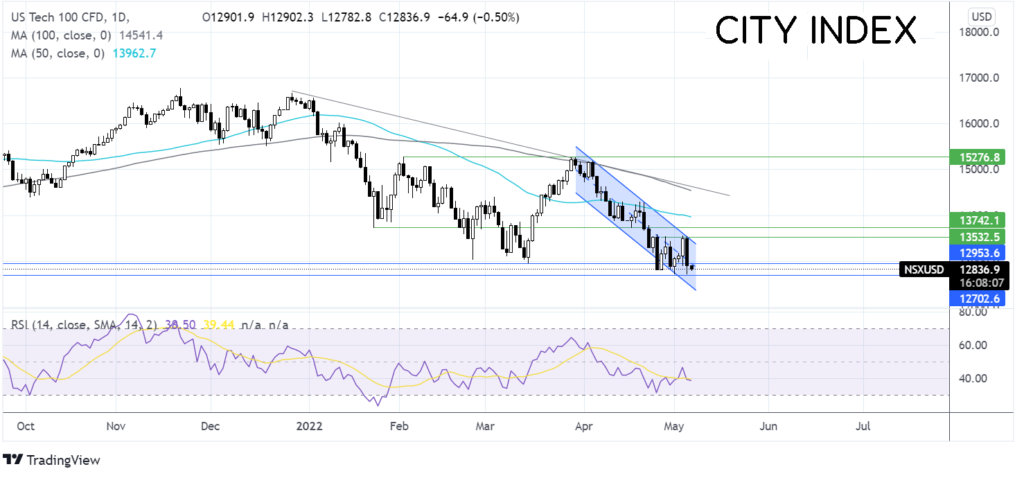Markets rocked by Fed and BoE jitters ahead of US jobs data

Nasdaq => The index falls below 13000
BTCUSD => The cryptocurrency falls to a 10-week low
GBP/CAD => The pair falls to a 5-year low
Nasdaq reverses post-Fed gains, NFP next.
The Nasdaq made a spectacular reversal in the previous session, wiping out the gains from the Fed’s decision day.
Federal Reserve Chair Jerome Powell’s comments that the central wasn’t considering a 75-basis point rate hike boosted stocks on Wednesday. However, inflation, stagflation, and hawkish Fed fears dragged US stocks and particularly the Nasdaq crashing lower yesterday.
Today attention will turn to the US nonfarm payroll report, which is expected to show that the labor market remained solid in April. At some point in the coming months, the Fed tightening monetary policy will become a headwind for the jobs market. But that is not now. Solid jobs data could help risk sentiment recover.
| U.S. non-farm payroll | Expected: 390k (41k) | Previous: 431k |

Where next for the Nasdaq?
The Nasdaq has been trading in a falling channel since the start of April.
The price failed to break through resistance at 13500 and tumbled lower before finding support at 12900. Sellers will need to break below 12900 and 12700, 2022 low, to head towards 12220, the pandemic low.
Any recovery would need to retake resistance at 13500 to test 13750 and expose the 50 sma at 14000.
Bitcoin breaks out of range
Bitcoin experienced its worst one-day selloff in over a month yesterday.
The cryptocurrency, which currently trades highly correlated to the stock market, fell by as much as 8% as the stock market tanked and optimism surrounding the Fed meeting evaporated. With the prospect of a higher interest rate environment limiting the upside, Bitcoin has mainly traded rangebound over recent weeks, failing to meaningfully push above 40k.
On the downside, BTC/USD has broken below support at 37.5k, opening the door to 35k.
GBP/CAD looks to Canadian unemployment after BoE battering
GBP/CAD tumbled 1.3% in the previous session to a 5-year low, as the loonie traced oil prices higher and the pound fell on recession fears.
The BoE, as expected, raised interest rates by 0.25%, putting the benchmark lending rate at 1%, a 13-year high. The vote was more hawkish than expected, with 3 of the nine policymakers voting to hike rates by 0.5%. However, the pound tumbled after the central bank warned of inflation rising to double digits, stagflation, and a steep economic slowdown.
Today the pair is increasing as attention turns to Canadian labor market data. Unemployment in Canada is expected to fall to a fresh record low, which will give the BoC more leeway to hike rates again to tame runaway inflation.
| Cad. unemployment | Expected: 5.2% (0.1) | Previous: 5.3% |
Support can be found at 1.5792 (2022 low) and 1.5740 (January ’17 low).
Resistance for the stock can be seen at 1.5936 (April 28 low) and 1.62 (May high).
